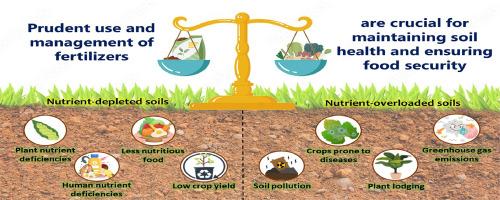采用协同保护方法,培育土壤、粮食安全和人类健康,实现可持续发展目标
IF 5.4
Q2 ENGINEERING, ENVIRONMENTAL
引用次数: 0
摘要
小农场广泛使用化肥有助于提高作物产量,支持粮食安全和经济增长。然而,最近的研究表明,这些化肥的使用效率往往不高,使用方法也不一致。这导致了环境危害、土壤养分失衡和粮食产量质量下降。这些问题威胁到对人类生存至关重要的粮食安全,并可能导致耕地荒芜。这种情况要求土壤保护研究发生重大转变,将科学发现与实际保护方法更好地结合起来,确保农业进步与环境可持续性齐头并进。有效使用氮(N)、磷(P)和钾(K)肥料对环境可持续性和粮食安全都至关重要。纠正营养失衡,尤其是错误施肥方法造成的氮磷钾比例失调,是确保营养供应平衡的关键。因此,采用平衡施肥技术对于将环境可持续性与全球粮食安全相结合以及实现可持续发展目标(SDGs)至关重要。为优化养分消耗和生产效率,应制定相关法规以执行 4R 原则,即以适当的比例、时间、方法和地点施用适当的养分来源。本文强调了当前农业实践、土地利用、化肥施用、土壤退化和未来挑战之间的联系。文章提倡环境友好型耕作方法,承认土壤质量、粮食安全、人类健康和环境可持续性之间的重要联系。本文章由计算机程序翻译,如有差异,请以英文原文为准。

Synergistic conservation approaches for nurturing soil, food security and human health towards sustainable development goals
Using chemical fertilizers extensively in small farms has helped increase crop yields, supporting food security and economic growth. However, recent studies show that these fertilizers are often used inefficiently and inconsistently. This leads to environmental harm, unbalanced soil nutrients, and lower-quality food production. These issues threaten food security, which is vital for human survival and may lead to the abandonment of arable land. This situation calls for a significant shift in soil conservation research to better connect scientific findings with practical conservation methods, ensuring that agricultural progress goes hand in hand with environmental sustainability. Effective use of nitrogen (N), phosphorus (P), and potassium (K) fertilizers is vital for both environmental sustainability and food security. Correcting nutritional imbalances, especially the disrupted N/P ratio caused by faulty fertilization practices, is key to ensuring a balanced nutrient supply. These imbalances have a substantial effect on aquatic and terrestrial ecosystems, altering their functionality, biodiversity and human nutrition Therefore, adopting balanced fertilization techniques is essential to combine environmental sustainability with global food security and achieve the Sustainable Development Goals (SDGs).To optimize nutrient consumption and production efficiency, regulations should be enacted to enforce the 4R principle, which involves applying the right nutrient source at the appropriate rate, time, method and location. This article emphasizes the connections between current agricultural practices, land use, fertilizer application, soil degradation, and future challenges. It promotes environmentally friendly farming methods that recognize the vital links between soil quality, food security, human health, and environmental sustainability.
求助全文
通过发布文献求助,成功后即可免费获取论文全文。
去求助
来源期刊

Journal of hazardous materials advances
Environmental Engineering
CiteScore
4.80
自引率
0.00%
发文量
0
审稿时长
50 days
 求助内容:
求助内容: 应助结果提醒方式:
应助结果提醒方式:


